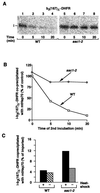Mitochondrial import driving forces: enhanced trapping by matrix Hsp70 stimulates translocation and reduces the membrane potential dependence of loosely folded preproteins
- PMID: 11564892
- PMCID: PMC99885
- DOI: 10.1128/MCB.21.20.7097-7104.2001
Mitochondrial import driving forces: enhanced trapping by matrix Hsp70 stimulates translocation and reduces the membrane potential dependence of loosely folded preproteins
Abstract
The mitochondrial heat shock protein Hsp70 (mtHsp70) is essential for driving translocation of preproteins into the matrix. Two models, trapping and pulling by mtHsp70, are discussed, but positive evidence for either model has not been found so far. We have analyzed a mutant mtHsp70, Ssc1-2, that shows a reduced interaction with the membrane anchor Tim44, but an enhanced trapping of preproteins. Unexpectedly, at a low inner membrane potential, ssc1-2 mitochondria imported loosely folded preproteins more efficiently than wild-type mitochondria. The import of a tightly folded preprotein, however, was not increased in ssc1-2 mitochondria. Thus, enhanced trapping by mtHsp70 stimulates the import of loosely folded preproteins and reduces the dependence on the import-driving activity of the membrane potential, directly demonstrating that trapping is one of the molecular mechanisms of mtHsp70 action.
Figures






Similar articles
-
Differential requirement for the mitochondrial Hsp70-Tim44 complex in unfolding and translocation of preproteins.EMBO J. 1996 Jun 3;15(11):2668-77. EMBO J. 1996. PMID: 8654364 Free PMC article.
-
Multiple interactions of components mediating preprotein translocation across the inner mitochondrial membrane.EMBO J. 1997 May 1;16(9):2205-16. doi: 10.1093/emboj/16.9.2205. EMBO J. 1997. PMID: 9171336 Free PMC article.
-
The protein import motor of mitochondria: unfolding and trapping of preproteins are distinct and separable functions of matrix Hsp70.Cell. 1999 May 28;97(5):565-74. doi: 10.1016/s0092-8674(00)80768-0. Cell. 1999. PMID: 10367886
-
The mitochondrial protein import motor.Biol Chem. 2000 Sep-Oct;381(9-10):943-9. doi: 10.1515/BC.2000.115. Biol Chem. 2000. PMID: 11076025 Review.
-
The preprotein translocase of the mitochondrial inner membrane: function and evolution.J Mol Biol. 1999 Feb 12;286(1):105-20. doi: 10.1006/jmbi.1998.2455. J Mol Biol. 1999. PMID: 9931253 Review.
Cited by
-
A cooperative action of the ATP-dependent import motor complex and the inner membrane potential drives mitochondrial preprotein import.Mol Cell Biol. 2007 Jan;27(2):411-25. doi: 10.1128/MCB.01391-06. Epub 2006 Oct 30. Mol Cell Biol. 2007. PMID: 17074805 Free PMC article.
-
An Hsp70 family chaperone, mortalin/mthsp70/PBP74/Grp75: what, when, and where?Cell Stress Chaperones. 2002 Jul;7(3):309-16. doi: 10.1379/1466-1268(2002)007<0309:ahfcmm>2.0.co;2. Cell Stress Chaperones. 2002. PMID: 12482206 Free PMC article. Review.
-
Age-dependent deficiency in import of mitochondrial DNA glycosylases required for repair of oxidatively damaged bases.Proc Natl Acad Sci U S A. 2003 Sep 16;100(19):10670-5. doi: 10.1073/pnas.1932854100. Epub 2003 Sep 5. Proc Natl Acad Sci U S A. 2003. PMID: 12960370 Free PMC article.
-
Mortalin/Hspa9 involvement and therapeutic perspective in Parkinson's disease.Neural Regen Res. 2023 Feb;18(2):293-298. doi: 10.4103/1673-5374.346487. Neural Regen Res. 2023. PMID: 35900406 Free PMC article. Review.
-
Mitochondrial Protein Import Dysfunction in Pathogenesis of Neurodegenerative Diseases.Mol Neurobiol. 2021 Apr;58(4):1418-1437. doi: 10.1007/s12035-020-02200-0. Epub 2020 Nov 12. Mol Neurobiol. 2021. PMID: 33180216 Review.
References
-
- Alconada A, Gärtner F, Hönlinger A, Kübrich M, Pfanner N. Mitochondrial receptor complex from Neurospora crassa and Saccharomyces cerevisiae. Methods Enzymol. 1995;260:263–286. - PubMed
-
- Bauer M F, Hofmann S, Neupert W, Brunner M. Protein translocation into mitochondria: the role of TIM complexes. Trends Cell Biol. 2000;10:25–31. - PubMed
-
- Bauer M F, Sirrenberg C, Neupert W, Brunner M. Role of Tim23 as voltage sensor and presequence receptor in protein import into mitochondria. Cell. 1996;87:33–41. - PubMed
-
- Bömer U, Maarse A, Martin F, Geissler A, Merlin A, Schonfisch B, Meijer M, Pfanner N, Rassow J. Separation of structural and dynamic functions of the mitochondrial translocase: Tim44 is crucial for the inner membrane import sites in translocation of tightly folded domains, but not of loosely folded preproteins. EMBO J. 1998;17:4226–4237. - PMC - PubMed
-
- Bukau B, Horwich A. The Hsp70 and Hsp60 chaperone machines. Cell. 1998;92:351–366. - PubMed
Publication types
MeSH terms
Substances
LinkOut - more resources
Full Text Sources
Molecular Biology Databases
